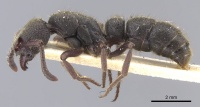Bothroponera henryi
| Bothroponera henryi | |
|---|---|

| |
| Scientific classification | |
| Kingdom: | Animalia |
| Phylum: | Arthropoda |
| Class: | Insecta |
| Order: | Hymenoptera |
| Family: | Formicidae |
| Subfamily: | Ponerinae |
| Tribe: | Ponerini |
| Genus: | Bothroponera |
| Species: | B. henryi |
| Binomial name | |
| Bothroponera henryi Donisthorpe, 1942 | |
Photo Gallery
Identification
Donisthorpe (1942): This distinct species comes nearest to tesserinoda, but differs by being considerably larger and having entirely different sculpture.
Distribution
Distribution based on Regional Taxon Lists
Oriental Region: India (type locality).
Distribution based on AntMaps
Distribution based on AntWeb specimens
Check data from AntWeb
Countries Occupied
| Number of countries occupied by this species based on AntWiki Regional Taxon Lists. In general, fewer countries occupied indicates a narrower range, while more countries indicates a more widespread species. |

|
Estimated Abundance
| Relative abundance based on number of AntMaps records per species (this species within the purple bar). Fewer records (to the left) indicates a less abundant/encountered species while more records (to the right) indicates more abundant/encountered species. |

|
Biology
Castes
Nomenclature
The following information is derived from Barry Bolton's Online Catalogue of the Ants of the World.
- henryi. Pachycondyla (Bothroponera) henryi Donisthorpe, 1942d: 449 (w.) INDIA (Tamil Nadu).
- Type-material: 2 syntype workers.
- Type-locality: India: Dohnavur, Tinnevelly Distr., 30.ix.1938, (Colombo Mus. Expd. Southern India) (G.M. Henry).
- Type-depository: BMNH.
- Combination in Bothroponera: Chapman & Capco, 1951: 50; Joma & Mackay, 2013: 2; Schmidt, C.A. & Shattuck, 2014: 77.
- Status as species: Chapman & Capco, 1951: 50; Bolton, 1995b: 306; Tiwari, 1999: 27; Bharti, Guénard, et al. 2016: 48.
- Distribution: India.
Description
Worker
Dark brown, mandibles, antennae, lobes of frontal carinas, posterior border of segments of gaster narrowly, and legs reddish, tarsi and apex of antennae lighter, teeth of mandibles black. Clothed with long outstanding and short decumbent yellow hairs. Sculpture consisting of large shallow punctures, space between more or less rugose and marked with fine small punctures.
Head large, subquadrate, broader than thorax, posterior angles rounded, posterior border slightly emarginate; mandibles large, triangular, finely striate, and with larger and smaller punctures, masticatory border armed with seven blunt teeth, the apical one longer and more pointed; clypeus narrow, with a medial carina, anterior margin bluntly pointed in centre; frontal carina large, lobes well developed; frontal furrow short, but rather wide and deep; antennal foveae large and deep; antennae long, stout, scape not reaching posterior border of head; first joint of funiculus if anything shorter than second, last joints thickened to apex, last joint somewhat flat, bluntly pointed, longer than the two preceding taken together; eyes moderate, oval, somewhat convex. Thorax narrowed to base; pronotum convex, rounded in front and at sides, pro-mesonotal suture distinct; meso-epinotal suture wanting; epinotum unarmed, gradually sloping to base, no marked angle between dorsal surface and declivity. Node of pedecil simple, unarmed, convex, rounded anteriorly and at sides; gaster narrowed to base, the constriction between the first and second segments very marked, the puncturation of the last segments not nearly so coarse as that of the rest of the body.
Length: 11 mm.
Etymology
This species was named in honour of Mr. G. M. Henry, who captured the ants of the expedition (to South India from September-October 1938).
References
- Donisthorpe, H. 1942d. Ants from the Colombo Museum Expedition to Southern India, September-October 1938. Ann. Mag. Nat. Hist. 11(9): 449-461. (page 449, worker described)
- Esteves, F.A., Fisher, B.L. 2021. Corrieopone nouragues gen. nov., sp. nov., a new Ponerinae from French Guiana (Hymenoptera, Formicidae). ZooKeys 1074, 83–173 (doi:10.3897/zookeys.1074.75551).
- Schmidt, C.A. & Shattuck, S.O. 2014. The higher classification of the ant subfamily Ponerinae (Hymenoptera: Formicidae), with a review of ponerine ecology and behavior. Zootaxa 3817, 1–242 (doi:10.11646/zootaxa.3817.1.1).
References based on Global Ant Biodiversity Informatics
- Donisthorpe H. 1942. Ants from the Colombo Museum Expedition to Southern India, September-October 1938. Annals and Magazine of Natural History (11)9: 449-461.


